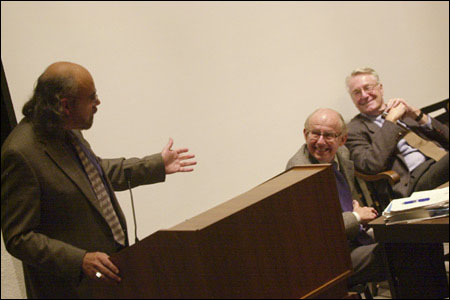What is an American? Discuss.
Author Huntington mixes it up with Carrasco and Little over national identity

Asking “Who am I?” may launch a quest to understand one’s own identity, but unless one happens to be Michel de Montaigne or Jean Jacques Rousseau, the effort is unlikely to be of much concern to anyone else.
But asking “Who are we?” is bound to be controversial, if only for the reason that so many “I’s” make up the collective “we,” and that each has a stake in defining the group to which he or she belongs.
Samuel Huntington, no stranger to controversy, asks exactly this question in his new book, “Who Are We?: The Challenges to America’s National Identity.” The book has sparked numerous impassioned responses, focusing particularly on Huntington’s assertions about the current wave of Latin American (and particularly Mexican) immigration.
Harvard Divinity School gave Huntington a chance to face some of his critics in a panel discussion Tuesday (Oct. 12). The panel was comprised of Huntington, the Albert J. Weatherhead III University Professor; David Little, the T.J. Dermot Dunphy Professor of the Practice in Religion, Ethnicity, and International Conflict; and Davíd Carrasco, the Neil L. Rudenstine Professor for the Study of Latin America.
Huntington went first. Addressing a diverse, standing-room-only crowd of graduate students, professors, and other interested individuals, he began by putting America’s national identity crisis in the context of the global shake-up of ethnicities brought on by higher levels of economic interaction, revolutions in communication and transportation, and increased waves of immigration. Other countries are asking the same questions we are, he said:
“Can Muslims be real French people? Can Turks be real Germans?”
“Who Are We?” asks whether recent Mexican immigrants, who are entering the United States in record numbers, can adopt what Huntington identifies as America’s core identity, characterized by the values planted here by America’s original English Protestant settlers – hard work, individualism, social reform, religiosity, and the rule of law. The question only takes up one chapter of the book, Huntington pointed out, but it is the chapter that has stirred up by far the greatest controversy.
To emphasize the importance of these core values, Huntington asked a simple question:
“Would America be the country it has been if it were settled by French, Spanish, or Portuguese Catholics? No, it would be French Canada, Mexico, or Brazil.”
Little questioned the way Huntington went about defining America’s national identity. Quoting Max Weber, he defined ethnic identity as “a subjective belief in common descent or common origins.” According to Little, the operative word here is “subjective.”
“The notion of national identity is normative, not descriptive. It is always a matter of ‘imagined selves,’ of what we want to be.”
People make their identities, Little said. Identities are socially constructed, often in the midst of conflict, to establish lines between insiders and strangers. They are dynamic, not static, and subject to contestation between majorities and minorities.
Little criticized Huntington for treating American Protestantism as if it were a homogeneous and monolithic force. Conflict over values abounded in the early colonial period, he pointed out. Roger Williams, for example, broke with the New England Puritans and went south to found the Rhode Island colony, asserting that atheists, Jews, Muslims, and other non-Christians should not be considered outsiders.
“Certainly this was a minority opinion, but Williams was a person who did not yield to the majority and continually contested the majority view,” Little said.
Carrasco, an anthropologist who has written extensively on the religion of the Aztec civilization, focused more on metaphors and imagery than on systematic analysis. He took exception with Huntington’s use of the word “core” to characterize America’s identity, suggesting that a better image would be that of the crossroads.
“The notion of a core has the virtue of clarity and simplicity, but the historical and ethnographic record suggests that culture is a crossroads or even a borderland.”
Carrasco also questioned Huntington’s alleged description of Mexicans as lazy and lacking in initiative, ambition, and independent spirit. “I simply do not know the people you describe here,” he said. (In replying to this criticism, Huntington pointed out later that these generalizations about Latin Americans were not his own but came from Latin American writers.)
Some of Carrasco’s strongest criticisms concerned bilingualism and the danger Huntington saw in allowing Spanish to become a second national language of the United States.
“The U.S. has been called the cemetery of foreign languages,” he said, referring to the hostility American schools and other institutions have demonstrated toward the retention by immigrants of their native languages.
He quoted studies showing that bilingual youngsters tend to do better on almost all cognitive tests and that most of them become fluent in English by age 17.
“In other words, we’ve got the crossroads in our brains, and we’re better off for it,” he said.




